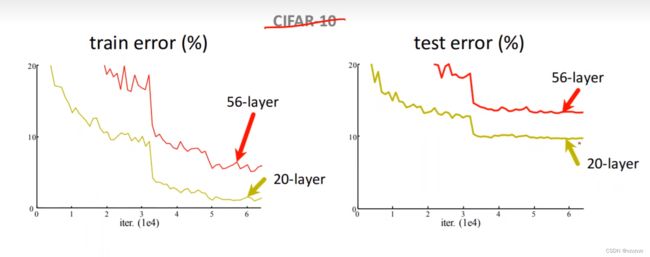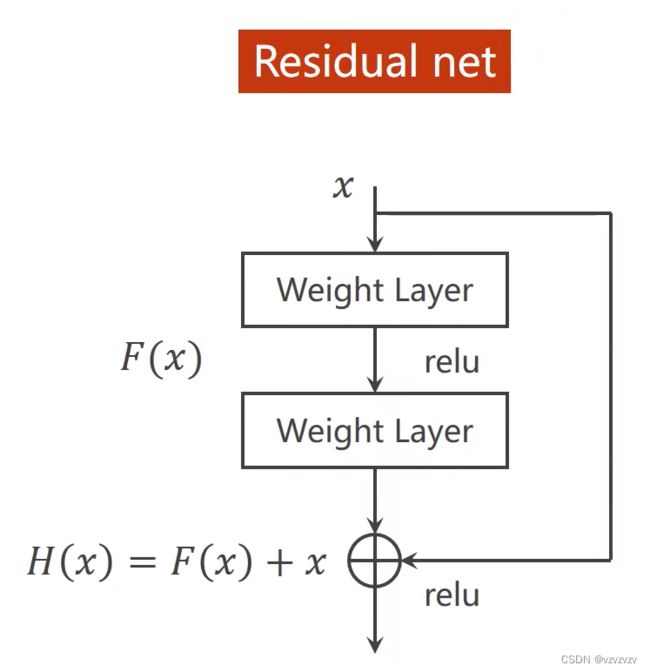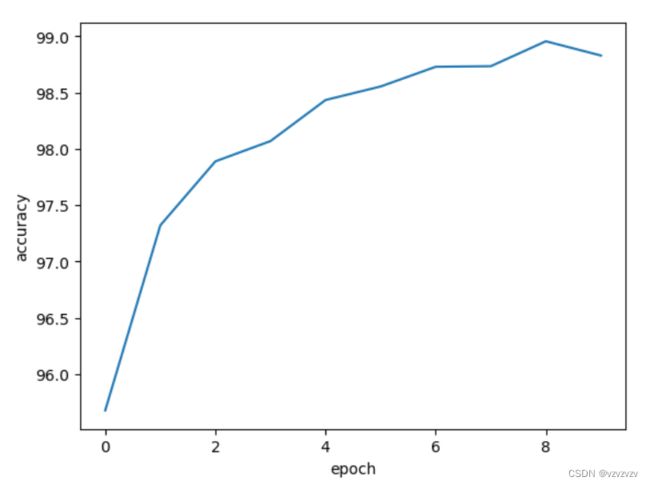PyTorch深度学习 学习记录6_2
文章目录
- 1x1的卷积核
- GoogleNet
- 梯度消失
1x1的卷积核
1x1的卷积核的主要目的是为了降维,在面对大量数据的时候运算量往往会变得非常大,那么1x1的卷积核能对数据进行处理,将维度降下来:
 像如上运算将三个通道降维了一个通道。经过这种处理我们在整个数据集上就会有一个显著的提升:
像如上运算将三个通道降维了一个通道。经过这种处理我们在整个数据集上就会有一个显著的提升:
 在我们是由1x1的卷积核以后尽管网络变得复杂了但是计算量缺少了一个量级,大幅降低了我们的计算时间。
在我们是由1x1的卷积核以后尽管网络变得复杂了但是计算量缺少了一个量级,大幅降低了我们的计算时间。
详情可见这里
GoogleNet
 以上的网络就是GoogleNet是现在常见的一种网络架构,虽然看着很恐怖但其中有很多和红圈中一样的重复的模块,这个模块称为为Inception,具体情况如下:
以上的网络就是GoogleNet是现在常见的一种网络架构,虽然看着很恐怖但其中有很多和红圈中一样的重复的模块,这个模块称为为Inception,具体情况如下:

其中的网络是并行处理的,我们把数据丢进去同时在多个网络中进行训练,哪个网络训练的好就赋予该网络更多的权重,就是做这样简单的事情,其模块的代码为:
import torch
import torch.nn
import torch.nn.functional as F
class InceptionA(torch.nn.Module):
def __init__(self,in_channels):
super(InceptionA,self).__init__()
self.branch1x1=nn.Conv2d(in_channels,16,kernel_size=1)
self.branch5x5_1=nn.Conv2d(in_channels,16,kernel_size=1)
self.branch5x5_2=nn.Conv2d(16,24,kernel_size=5,padding=2)
self.branch3x3_1=nn.Conv2d(in_channels,16,kernel_size=1)
self.branch3x3_2=nn.Conv2d(16,24,kernel_size=3,padding=1)
self.branch3x3_3=nn.Conv2d(24,24,kernel_size=3,padding=1)
self.branch_pool=nn.Conv2d(in_channels,24,kernel_size=1)
def forward(self,x):
branch1x1=self.branch1x1(x)
branch5x5=self.branch5x5_1(x)
branch5x5=self.branch5x5_2(branch5x5)
branch3x3=self.branch3x3_1(x)
branch3x3=self.branch3x3_2(branch3x3)
branch3x3=self.branch3x3_3(branch3x3)
branch_pool=F.avg_pool2d(x,kernel_size=3,stride=1,padding=1)
branch_pool=self.branch_pool(branch_pool)
outputs=[branch1x1,branch5x5,branch3x3,branch_pool]
return torch.cat(outputs,dim=1)#把channel的维度拼起来
还是使用MNIST数据集我们简单做一个网络:
class Net(nn.Module):
def __init__(self):
super(Net,self).__init__()
self.conv1=nn.Conv2d(1,10,kernel_size=5)
self.conv2=nn.Conv2d(88,20,kernel_size=5)
self.incep1=InceptionA(in_channels=10)
self.incep2=InceptionA(in_channels=20)
self.mp=nn.MaxPool2d(2)
self.fc=nn.Linear(1408,10)
def forward(self,x):
in_size=x.size(0)
x=F.relu(self.mp(self.conv1(x)))
x=self.incep1(x)
x=F.relu(self.mp(self.conv2(x)))
x=self.incep2(x)
x=x.view(in_size,-1)
x=self.fc(x)
return x
梯度消失
通常会认为将网络越叠越深我们会不断提高网络的性能,但实际上并不会这样:
 我们能看到56层的网络远不如20层的网络,过高的层数意味着我们的反向传播会变得很长,链式法则是通过相乘进行运算的,也就是说我们反向传播的过程中有许多小于1的数最终的结果会变得可以忽略不记,在计算机中甚至可能会由于精度问题直接下溢,这种情况被称为梯度消失。为了解决这个问题我们引入residual net(残差网络)
我们能看到56层的网络远不如20层的网络,过高的层数意味着我们的反向传播会变得很长,链式法则是通过相乘进行运算的,也就是说我们反向传播的过程中有许多小于1的数最终的结果会变得可以忽略不记,在计算机中甚至可能会由于精度问题直接下溢,这种情况被称为梯度消失。为了解决这个问题我们引入residual net(残差网络)

在激活之前我们将H(X)对X求导 ∂ H ( x ) ∂ x = ∂ F ( x ) ∂ x + 1 \frac{\partial{H(x)}}{\partial{x}}=\frac{\partial{F(x)}}{\partial{x}}+1 ∂x∂H(x)=∂x∂F(x)+1那么即使发生梯度消失最终的值也会在1附近,这样我们就可以对比较前面的层进行更好的学习。
代码块:
class ResidualBlock(nn.Module):
def __init__(self,channels):
super(ResidualBlock,self).__init__()
self.channels=channels
self.conv1=nn.Conv2d(channels,channels,kernel_size=3,padding=1)#保证输入输出的通道数不变
self.conv2=nn.Conv2d(channels,channels,kernel_size=3,padding=1)
def forward(self,x):
y=F.relu(self.conv1(x))
y=self.conv2(y)#在激活之前
return F.relu(y+x)
class Net(nn.Module):
def __init__(self):
super(Net2,self).__init__()
self.conv1=nn.Conv2d(1,16,kernel_size=5)
self.conv2=nn.Conv2d(16,32,kernel_size=5)
self.mp=nn.MaxPool2d(2)
self.rcblock1=ResidualBlock(16)
self.rcblock2=ResidualBlock(32)
self.fc=nn.Linear(512,10)
def forward(self,x):
batch_size=x.size(0)
x=self.mp(F.relu(self.conv1(x)))
x=self.rcblock1(x)
x=self.mp(F.relu(self.conv2(x)))
x=self.rcblock2(x)
x=x.view(batch_size,-1)
print(x.size(1))
x=self.fc(x)
return x
